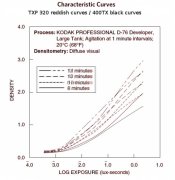TXP has always been considered a professional film, and has never to my knowledge been available in 35mm, where most amateurs live. Perhaps Kodak has a long established habit of expecting more of professional photographers, and thinks they might read the tech info they provide and notice the difference when they print, rather than presuming that two films with different speeds are the same.
Here are the first paragraphs of the tech info bulletin:
KODAK PROFESSIONAL TRI-X 320 and 400 Films are high-speed panchromatic films that are a good choice for photographing dimly lighted subjects or fast action, for photographing subjects that require good depth of field and fast shutter speeds, and for extending the distance range for flash pictures. TRI-X 400 Film (400TX) is available in120 and 135 sizes and 35 and 70 mm long rolls. You can retouch the 120-size film on the emulsion side. TRI-X 400 Film is recommended for push-processing applications.
TRI-X 320 Films (320TXP) feature excellent tone gradation and brilliant highlights. They are especially well suited to low-flare interior lighting or flash illumination. They are also useful for portraiture with low-contrast backlighting outdoors.
One TRI-X 320 Film (320TXP) is available in 120 and 220 sizes on a 3.9-mil acetate base, the other is available in sheets on a 7-mil ESTAR Thick Base. You can retouch
these films on the emulsion or base side.
The overlaid film curves for TXP and 400TX are attached. In the chart TXP development times are 8, 10, 12, and 14 minutes, 400TX development times are 6, 8, 10, and 12 minutes.
Notice that tungsten filter factors in the tech info bulletin also differ between the films.
Lee







